Learn & Discover
Learn & Discover
A history of sparkling cider
Think of Champagne and what comes to mind? The Great Gatsby? New Year’s Eve? Formula 1? What about cider?
Cider and Champagne may seem far cries from one another, but there is more than meets the eye when it comes to the relationship between the two. In fact a lot of what works to bring Champagne’s vivacious fizz to life was used on Cider first, to the point where Champagne may not be the drink it is today without the existence of Cider.
Don’t believe me? Well, let’s go on a little history lesson, shall we?
Rachel Hendry
A wine and cider writer, featured in Wine52’s Glug magazine, Pellicle magazine, Burum Collective and Two Belly. The mind behind wine newsletter J’adore le Plonk and an untiring advocate for spritzing every drink she can get her hands on.
What Makes a Good Harvest?
Harvest is often seen as a magical time of abundance, but for the agricultural workers whose labour is tied so closely with that of their orchards, the run up to harvest can be an anxious time. Without apples to harvest there would be no cider to drink or sell. Consequently, there is no income—a travesty for both maker and consumer.
Part of this anxious magic is that no two harvests are the same; vintages exist in order to help categorise a fruit and their juice by the year they were grown. So what elements are at work to make one harvest differ to another? Is there such a thing as a good and a bad harvest? What is needed to make a harvest one of abundance over anxiety?
Rachel Hendry
A wine and cider writer. The mind behind wine newsletter J’adore le Plonk.

In The Beginning There Was Pét-Nat
Before there was Champagne there was Méthode Ancestrale, the name given to pétillant-naturel style sparkling drinks. Ancestral because it’s a method of carbonating drinks that predates traditional methods and, unlike most methods of carbonating cider today, involves only one fermentation.
This simplified form of sparkling wine is often traced back to 1531 Limoux, France. The monks who were cultivating vineyards at the time supposedly discovered that by bottling their wine ever so slightly earlier than usual the last of the carbon dioxide would become trapped in the bottle, causing a soft, foamy fizz.
Now you’d be right to point out that this was a method used in winemaking, not cider making. But there is no such thing as original thought, and it’s important to know which sparkling methods were already in use during the sixteenth century before we go onto some rather exciting sparkling cider history.

In The Beginning There Was Pét-Nat
Before there was Champagne there was Méthode Ancestrale, the name given to pétillant-naturel style sparkling drinks. Ancestral because it’s a method of carbonating drinks that predates traditional methods and, unlike most methods of carbonating cider today, involves only one fermentation.
This simplified form of sparkling wine is often traced back to 1531 Limoux, France. The monks who were cultivating vineyards at the time supposedly discovered that by bottling their wine ever so slightly earlier than usual the last of the carbon dioxide would become trapped in the bottle, causing a soft, foamy fizz.
Now you’d be right to point out that this was a method used in winemaking, not cider making. But there is no such thing as original thought, and it’s important to know which sparkling methods were already in use during the sixteenth century before we go onto some rather exciting sparkling cider history.
Or LOG IN for unlimited access to Learn & Discover
JOIN CAMRA
Or JOIN CAMRA for unlimited access to Learn & Discover
Section sub title goes here
Lorem ipsum dolor sit amet, consectetur adipiscing elit. Nullam lobortis vel sapien nec faucibus. Morbi consectetur pulvinar lectus, vitae sodales tellus. Sed sagittis aliquam convallis. Duis mollis libero eu massa luctus, id euismod urna fringilla. Aenean condimentum accumsan leo nec eleifend. Maecenas ullamcorper est non justo pulvinar accumsan. Nam facilisis, lacus a aliquet ornare, metus velit mattis leo, eget sodales quam ligula et nisl.




